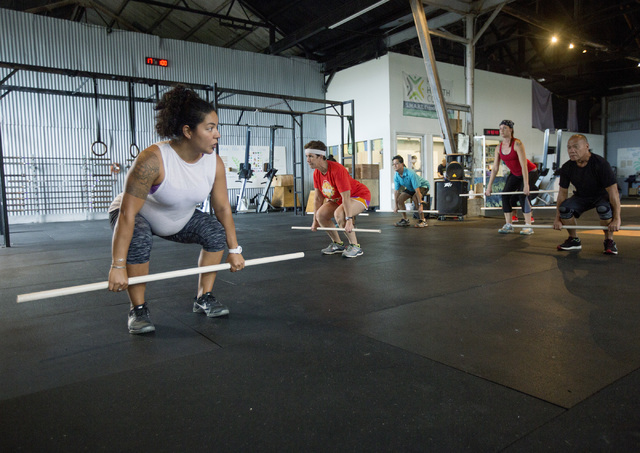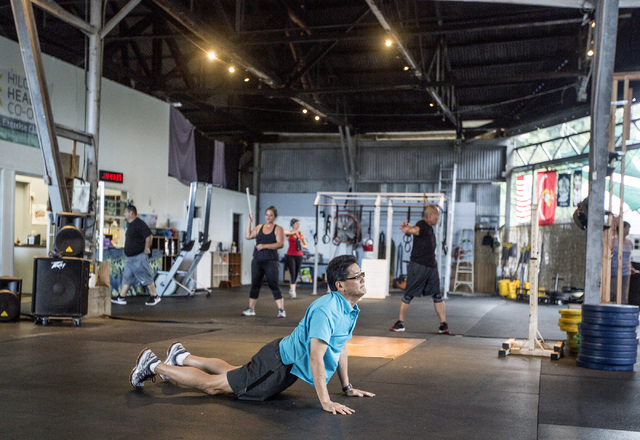Gordon Aguiar, 54, of Hilo felt a touch of apprehension the first time he headed into the Hilo Health Cooperative. ADVERTISING Gordon Aguiar, 54, of Hilo felt a touch of apprehension the first time he headed into the Hilo Health
Gordon Aguiar, 54, of Hilo felt a touch of apprehension the first time he headed into the Hilo Health Cooperative.
But he stuck with the exercise programs, which are designed to trigger collaboration and mutual support.
Since he began attending group sessions in May, his blood pressure, cholesterol and weight have dropped. His doctor is considering a lower dose for his medications. He feels more positive, and his stamina and flexibility have improved.
He also appreciates satisfaction-producing topics the fitness center focuses on from time to time, such as to perform random acts of kindness daily or to choose someone you’re grateful for and then tell that person why.
“The Hilo Health Cooperative is the first cooperative exercise center in the U.S.,” said Grif Frost, business development specialist. “Instead of a ‘competitive’ exercise environment, where ‘I am better than you’ or ‘I look better than you,’ a cooperative exercise center offers instructor-led classes where everyone works together to help themselves, as well as others, get on the path and, more importantly, stay on the path to optimum health.”
Optimum health, he said, is measured by assessments that measure true body age, quality of life and fitness level.
The co-op, in collaboration with the East Hawaiian Independent Physicians Association, will soon finish one of several research studies organizers are using for program planning.
The studies set the center apart because planners drop what doesn’t work and permanently add study-proven techniques that do.
Medical Studies of Cooperative Exercise include:
• 25 participants referred by six area physicians who wanted their patients to focus on exercise instead of drugs “to help solve the root causes of poor health.”
• 50 participants without the need for physician referral. Ending soon, the 16-week program also includes a healthy eating program.
• 75 participants, beginning Jan. 16, without a physician-referral requirement. Costs include $50 for before and after assessments, a monthly fee for unlimited class attendance and $25 to join the healthy eating program.
More than 100 Hilo Health Cooperative members currently pay $95 a month and agree to attend sessions in order to keep their memberships.
“Many gyms make money by not have people use the gym,” Frost said.
“We are just the opposite. We require regular attendance or we cancel their membership.”
Isn’t $95 a month pretty pricey?
Frost said one of the center’s members overheard someone saying he could get a membership at a different fitness center for $30 a month.
But the member interjected, “What is your health worth?”
Class sessions cost, on average, about $8 apiece if a member goes to three classes per week, Frost said.
Hilo Health Cooperative’s research has demonstrated that members do best when they attend group sessions three times a week. Not two. Not four. Three.
Research results like that get shared with members, and a University of Hawaii at Hilo peer-reviewed journal article is planned.
Aguiar works for a regional health supplier and delivers 55-pound oxygen tanks.
Despite the heavy lifting, he sits a lot during the day.
He also used to eat lunch and snack on his lengthy commutes.
But, early on, he randomly read a club member’s note on the center’s discussion board, which said to “stop eating while driving.”
That hit home and Aguiar said he changed his behavior — and it made a difference.
Simple changes like that can have a profound impact, Aguiar said.
Hilo Health Cooperative planners hope to eventually offer their framework so similar centers can be opened in other communities nationwide. They also hope for more centers in East Hawaii close to where people live.




